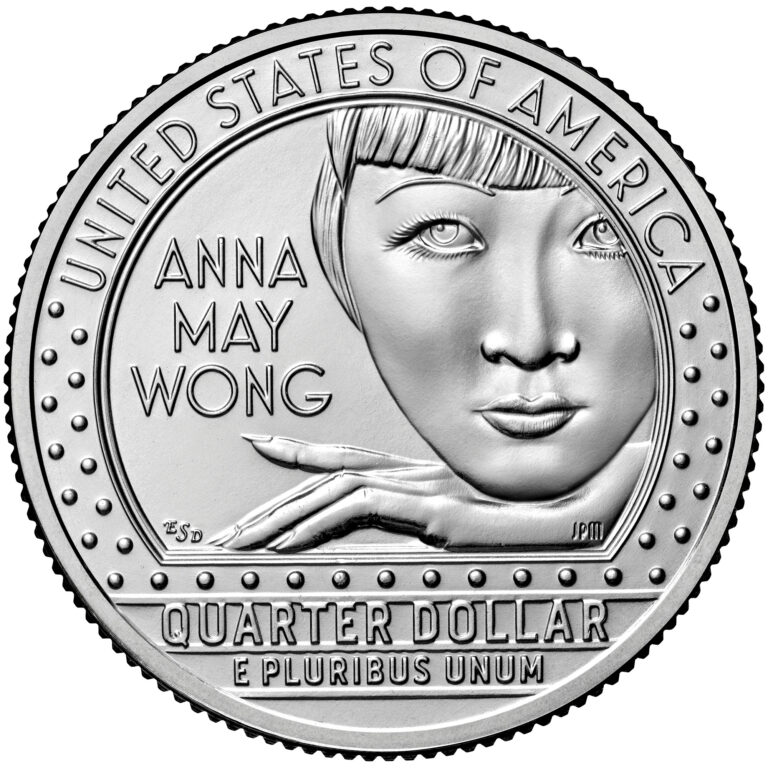The American Women Quarters initiative from the U.S. Mint is designed to honor women change-makers in U.S. history, including:
- Maya Angelou, writer
- Anna May Wong, Asian American actress
- Sally Ride, first woman in space
- Wilma Mankiller, first elected woman principal chief of the Cherokee Nation
- Nina Otero-Warren, New Mexico suffrage movement leader
 "The U.S. Mint's American Women Quarters Program celebrates five female trailblazers in American history each year between 2022 and 2025. Anna May Wong is featured on the fifth coin released in 2022." | Public Domain
"The U.S. Mint's American Women Quarters Program celebrates five female trailblazers in American history each year between 2022 and 2025. Anna May Wong is featured on the fifth coin released in 2022." | Public Domain
The U.S. Treasury also plans to bring forth an image of Harriet Tubman on the $20 bill, but not till 2030.
Given their constant use, the images on banknotes and coins become part of everyone's accepted stock of knowledge and important topics for critical media analysis. We take for granted that George Washington looked like just he appears on the $1 bill, Alexander Hamilton like he does on the $10 bill, and so on.
At the same time, the vast majority of images on U.S. money have been of White men, conveying a message that women and people of color are less deserving of the honor of currency recognition.


 Watch on YouTube
Watch on YouTube
The history of women and people of color on currency are largely untold stories. Since World War I, women have appeared only on coins, namely Susan B. Anthony, Sacagawea, and Helen Keller. Martha Washington appeared on $1 silver certificates in 1886 and Pocahontas on the $20 bill in the 1860s. Booker T. Washington was the first African American on a coin in 1946; Jackie Robinson, Duke Ellington, Rosa Parks, Martin Luther King, Jr. and Coretta Scott King, and the Tuskegee Airmen, among others have appeared since then. A Native American figure appeared on the Indian Head penny, but the model was a liberty lady wearing an Native American head-dress; only a few million Buffalo nickels were minted in the early 20th century.
In these activities, you will analyze how women and people of color have been displayed on currency before proposing new images that suggest their importance and impact on American society and culture.
Activity 1: Examine the Images of Women and People of Color on Currency
- Explore the following resources about women, African Americans, and Native Americans on money:
- Select one currency image featuring a woman, African American, or Native American and critically evaluate it using the Teacher and Student Guide to Analyzing Images.
- Create a video, screen recording, or interactive image to present your findings.
- Interactive image:
- Start a new Google Drawings canvas.
- Upload a screenshot of the currency image to the middle of the canvas.
- Insert text boxes and shapes to call attention to your findings.
- Add links to additional information (e.g., the original image source).
- Screenrecording:
Activity 2: Campaign for Changes in the Images on Currency
- Select a woman, Native American, Black American, or other traditionally marginalized individual who you believe deserves to be on U.S. currency.
- Then, design a social media campaign to encourage people to write to political leaders to add that individual to U.S. currency.
- The social media campaign should include at least 2 videos (e.g., YouTube, Snapchat, TikTok), 5 example posts, and 3 images (e.g., memes, graphics, infographics) designed by you.
- Make sure to describe why the person you selected should be on U.S. currency.
- Bonus: Create a prototype drawing (digital or pencil/paper) of what the currency might look like with the individual you selected on it.
Activity 3: Design Images for Digital Currency
Digital currency is emerging as a means of exchange around the world. For example, early in 2021, China began testing in cities its own homegrown digital currency, the Electronic Chinese Yuan (New York Times, March 1, 2021).
- Design a digital currency for use by the United States and other countries featuring influential individuals from history.
- You can use the following Create Your Own Currency app from the Federal Reserve Bank of Chicago to assist with your design process.
 Federal Reserve Bank of Chicago App Screenshot
Federal Reserve Bank of Chicago App Screenshot
Additional Resources
Connecting to the Standards
- Massachusetts Civics & Government Standards
- Analyze the Constitutional issues that caused the Civil War and led to the eventual expansion of the power of the federal government and individual civil rights. (Massachusetts Curriculum Framework for History and Social Studies) [8.T5.3]
- ISTE Standards
- Digital Citizen
- 2c: Students demonstrate an understanding of and respect for the rights and obligations of using and sharing intellectual property.
- Knowledge Constructor
- 3a: Students plan and employ effective research strategies to locate information and other resources for their intellectual or creative pursuits.
- 3b: Students evaluate the accuracy, perspective, credibility and relevance of information, media, data, or other resources.
- 3d: Students build knowledge by actively exploring real-world issues and problems, developing ideas and theories and pursuing answers and solutions.
- Creative Communicator
- 6a: Students choose the appropriate platforms and tools for meeting the desired objectives of their creation or communication.
- 6b: Students create original works or responsibly repurpose or remix digital resources into new creations.
- 6d: Students publish or present content that customizes the message and medium for the intended audiences.
- DLCS Standards
- Ethics and Laws (CAS.b)
- Interpersonal and Societal Impact (CAS.c)
- Digital Tools (DTC.a)
- Collaboration and Communication (DTC.b)
- Research (DTC.c)
- English Language Arts > History/Social Studies Common Core Standards
- CCSS.ELA-LITERACY.RH.6-8.7
- CCSS.ELA-LITERACY.RH.9-10.7
- CCSS.ELA-LITERACY.RH.11-12.7